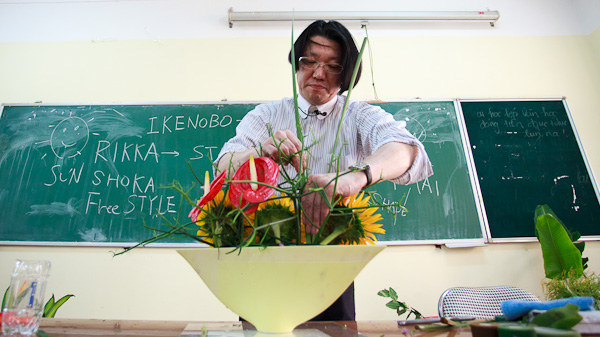On May 12, 2011, the Department of Oriental Studies held a presentation and guidance session on the Ikenobo style of Ikebana flower arrangement. Professor Sasaki Yasuhito, a cultural ambassador of the Japanese government, from the Ikenobo School Research Institute (a school of Ikebana art), directly participated in the presentation and guided students on the Shoka Shofutai style of flower arrangement.Ikenobo is the origin of Japanese Ikebana. For over 550 years, Ikenobo has always been harmonious and close to people, creating diverse styles of flower arrangement to reflect the soul of people of different eras.

A common thread in all forms of Ikebana flower arrangement, despite their differences, is the "beauty of plants." The most important aesthetic element of Ikebana is the appreciation of natural beauty and the resilience of each plant to thrive and live for the future. In the Ikenobo school of flower arrangement, not only blooming flowers but also buds, branches, and leaves are used to express the beauty of life, as they are full of vitality and look towards the future.

Past, present, future... in every moment, plants and humans alike are constantly adapting to a ever-changing environment. Like plants, humans are an essential element of nature, and this is even more deeply felt when arranging flowers. Today, the Ikenobo school has three styles of flower arrangement: "Rikka" (Standing Flowers), "Shoka" (Living Flowers), and the modern form "Jijuka" (Free Flowers). During the presentation, Professor Sasaki Yasuhito provided detailed guidance to students on the Shoka Shofutai style – a style that simply expresses the natural beauty of plants by using few branches and leaves. This style reflects the upward growth towards the sun and the unique characteristics of plants. Student Phung Thu Ha (K55, majoring in Japanese Studies) said: "The extracurricular activity helped me accumulate more knowledge, not only giving me the opportunity to practice Japanese but also to learn more about Japanese culture." It is known that the presentation and instruction on Ikebana flower arrangement is one of the extracurricular activities for Japanese Studies students, providing opportunities for students to improve their Japanese language skills and learn about Japanese culture. On May 16th, the Faculty of Oriental Studies will also organize the second "Japanese Language Gala."


